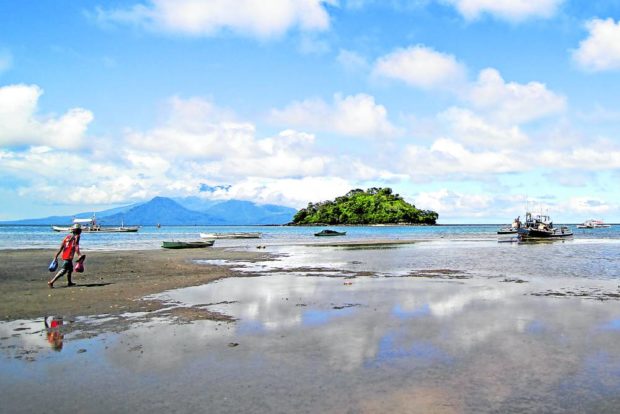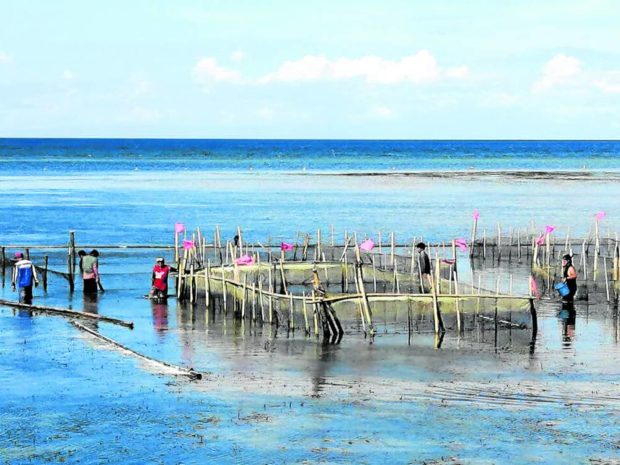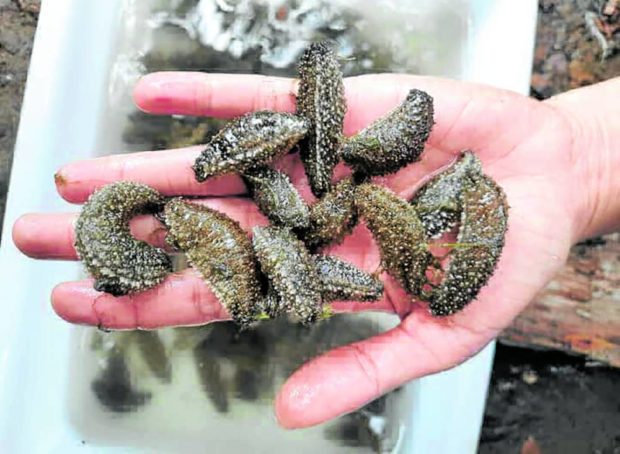Sea cucumbers change lives in Camiguin

TOURISM GEM IN NORTH MINDANAO | Gifted with unspoiled beaches, nature parks and springs, the volcanic island of Camiguin is one of the leading ecotourism destinations in the Northern Mindanao region. The province’s fishing communities are also seen to benefit from a government project that will propagate sea cucumbers for the international market. (Photo by ERWIN MASCARIÑAS / Inquirer Mindanao)
DAVAO CITY, Davao del Sur, Philippines — Among fisherfolk in the coastal community of Benoni in Mahinog town on Camiguin Island, a species of sea cucumber is often eaten as “kinilaw” (marinated in vinegar and spices) or “balbacua” (stew).
But outside of fishing families who cook these delicacies for their own consumption, sea cucumbers, locally known as “balat” (pronounced ba’t), are not that popular in the Philippine market, said Dr. Wilfredo Uy, the head of the Sea Cucumber Research and Development Center at Mindanao State University (MSU) Naawan campus in Misamis Oriental province.
“You don’t see them in groceries, except in specialty marts; but in the global market, yes. They enjoy such a high demand and the price is very, very nice,” Uy told a recent gathering of the Mindanao cluster of the Science for Change Program (S4CP) here.
Sea cucumber cultivation is among the projects cited by the Department of Science and Technology (DOST) to have the potential to bring change to the lives of people. Even during the pandemic, the sea cucumber project piloted by MSU Naawan at Benoni village in Mahinog, Camiguin, sustained community members, enabling them to survive the lockdown, according to village chief Asterio Mabale Jr.
Traded in their dried form and known by the trade names “trepang,” or “bêche-de-mer,” sea cucumbers sell for as much as P4,000 to P8,000 a kilo in the local market alone. A known aphrodisiac so loved by the Chinese, they fetch as much as three to four times the local prices in the international market, said Uy.
Intrigued by its potentials, Uy first tried to set up a sandfish (common name for Holothuria scabra) hatchery at MSU Naawan campus in 2012. “But that was 10 or 15 years ago, when it was very difficult to access funds from the DOST if you are from Mindanao,” he said.
MSU Naawan instead decided to partner with another academic institution, the University of the Philippines Marine Science Institute, and together, they accessed funds from the Australian Centre for International Agricultural Research.
“We set up a hatchery and proved that we can do it,” he said, referring to the MSU Naawan hatchery, which first focused on the hatching of species Holothuria scabra known locally as “balat kagisan.”
He pointed out, however, that unlike the species consumed by local fisherfolk, “balat kagisan” are bigger sea cucumber species with harder skin. “They’re not usually consumed in the local market,” he told the Inquirer. “They’re usually traded by handlers and transported straight to the markets abroad.”
Funds for R&D
In 2016, the DOST implemented its S4CP, addressing the disparity of funding for research and development (R&D) in the regions.
Undersecretary Rowena Cristina Guevara said that when they assumed office in 2016, 75 to 80 percent of DOST funds for R&D went to Metro Manila, Calabarzon (Cavite, Laguna, Batangas, Rizal and Quezon) and Central Luzon, while 25 to 20 percent of the funds were being shared by the rest of the 14 regions.
“So, we thought, talent could not be concentrated in just these three regions. It has to be all over the country,” Guevara said.
One of the subprograms of S4CP, the Niche Centers in the Regions for R&D (Nicer), addressed this by providing grants to universities in the regions to undertake quality research, promote regional development and encourage industrial competitiveness.
MSU Naawan was able to tap funds from the Nicer program in 2019 to expand its sea cucumber hatchery, piloting areas in Benoni village in Mahinog and in the towns of Lopez Jaena and Plaridel in Misamis Occidental province.

LIVELIHOOD OPPORTUNITY | “Grow-out” pens for sea cucumbers are being built in Camiguin province as part the Department of Science and Technology’s (DOST) Science for Change Program. Under its Niche Centers in the Regions for R&D, fisherfolk are trained to cultivate sea cucumbers. (Photo courtesy of the DOST)
Environmental awareness
Years before his village piloted the Nicer project, Mabale, barangay captain of Benoni, had championed environment protection in his place.
Seeing the damage on coral reefs and seagrass in Mahinog, Mabale, president of the Association of Barangay Captains, authored an ordinance banning fishing and gathering of marine products in the area.
“It was very hard, the community was angry because of the loss of their livelihood but I pushed on because of the damaged environment,” he said at a forum here.
After three years of the ban, marine life thrived again in Mahinog, prompting Mabale to author another ordinance declaring a close and open season for fishing and gathering of any marine products in the area.
He also authored an ordinance that banned the use of sharp, bladed instruments in extracting seashells and another measure expanding the 6-hectare marine sanctuary into 21 ha.

PRECIOUS SEA CREATURES | Juvenile sea cucumbers (Holothuria scabra) are hatched from the Mindanao State University Naawan hatchery in Misamis Oriental. (Photo courtesy of the DOST)
Crucial role
As a result, the town won the Malinis at Masaganang Karagatan Award by the Bureau of Fisheries and Aquatic Resources in 2018 and this year, the town is among the top five being nominated for the prize.
Although their fishing community in Benoni already knew balat, the barangay was not yet aware of the crucial role played by sea cucumbers in keeping the marine ecosystem healthy, Mabale said. “It was the DOST’s Nicer project that introduced us to it,” he noted.
Sea cucumbers clean sediments, prevent algal bloom and protect coral reefs through their alkalinity, according to a book produced by the DOST on the S4CP. Aside from these, the calcium carbonate released in their waste serves as building blocks for corals, said the book authored by Science and Technology Secretary Fortunato de la Peña and Undersecretary Guevara.
Mabale said he became very interested when Uy, in 2019, approached him for the Nicer project and told him about the importance of sea cucumbers in the environment and its impact on the economic livelihood of the community.
After getting the support of the local government, and with materials provided by MSU Naawan through the Nicer program, two fisherfolk groups in Benoni started constructing pens in 2019.
“It was very timely because it was the height of the pandemic. We had a lockdown and the allowances that the community got from monitoring and construction work provided them enough cash to survive,” he said.
Export market
Uy said the goal, in the long run, would be for the communities to hatch sea cucumbers in volume that would eventually allow the community beneficiaries to export these. Their pilot areas in Camiguin and in Misamis Occidental have been serving as both training and teaching centers for the hatching and handling of sea cucumbers and, at the same time, as learning centers for other towns to learn the techniques.
“Economically, as a livelihood project, the project helped us a lot because it arose during the worst time of the pandemic, when life was hard, it was such a great help. Environmentally, we all know that sea cucumbers are nutrient recyclers, so I embraced the project because of my love for marine life,” Mabale said.
Uy said MSU Naawan’s Nicer project would end this year but they were seeking a three-year extension.
For Mabale, he said he felt at a loss upon knowing that the program was about to end.
“Ako po’y lubos na nababahala (I’m extremely worried),” he said. “Sana po ay maipagpatuloy at suportahan ang proyektong ito, di lang po para sa kalikasan kundi para rin sa pag-angat ng buhay ng bawat mamamayan (I hope that support for the project will continue not only for the sake of the environment but also to uplift the lives of the communities).”
RELATED STORIES
Guimaras farmers benefit from DAR’s sustainable livelihood project
Siargao resto’s woven pizza boxes: Eco-friendly livelihood for Tangbo weavers